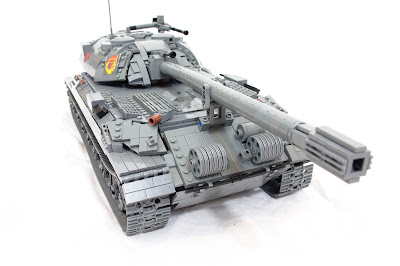Scale 1/18th
Powertrain: XL motor
Steering: L motor
Transmission selector: Servo motor
Turret traverse: M motor
Gun elevation: M motor
KPVT HMG traverse: M motor
Control: 2 Sbricks
Suspension: Torsion bar
The complex curves and sharp angles of the IS-7 Soviet heavy tank proved to be one of the more challenging models to replicate in Lego form.
I began the design process in November 2016, I wanted to replicate the functionality of a dual differential steering mechanism in one of my models, though the current solutions developed by other builders were too bulky for my liking, thus adding the functionality of such a system would utilize lots of space that could be better used for other details such as the engine bay. I also wanted an integrated transmission of some sort, as this would make the vehicle more functional like its real world counterpart. To solve the issue with the bulkiness of the steering mechanism, I decided to orient the differentials parallel to the drive sprockets, this helps reduce a majority of the bulk from other designs, as it eliminates unnecessary gearing to connect the final drives to the steering mechanism, and it also makes it easier to couple the outer gearing of the differentials for the steering motor. With several revisions of the steering unit after being built in real bricks, I was satisfied with the performance and functionality.
instructions for the steering mechanism available here.
In December 2016 I began by modeling the curves of the turret in a digital building software, as this part would be the most challenging component of the entire model. This took over eight revisions to tweak the turret's outer shape. The front "cheeks" of the turret were also difficult, as the shape of the curve is rather shallow and they sweep outwards to connect with the front of the turret. During my Christmas break from college, I had three weeks to further work on the hull and build the turret from several Bricklink orders. During my spring break in late February I was able to continue work on the model, by adding the M-50T V12 engine to the rear of the model, and I began work on the pike shaped armor in the front. The pike is a common feature of Cold War era Soviet armor design, it also being found on the IS-3 tank. As my second year of college came to a close, I was finally free to make the final push and complete one of the last challenges, mating the turret with the hull and fitting the mechanisms into the rather compact space of the turret. This task is usually rather easy, when building from the hull and the turret last, though working with a preexisting turret design was another challenge. To provide some example of the space in the turret, there is only a 4 stud high clearance in the turret, and a Lego M motor takes up 3 of the 4 studs of space. Through several trials and adjustments I managed to mount 2 M motors, and an Sbrick. I had originally planned to mount an autoloader in the turret, or mount the battery in the turret, but these proved to be impossible due to the space constraints.
I am very pleased about the ability to mount the V12 engine, as one of the challenges with this was to connect the motor to the input for the XL motor. This may seem rather easy at first, though the spacing between the two parts isn't a perfect fit for two gears. I first tried using rubber bands and chain, though wasn't pleased with the backlash in either of those solutions. The design for the engine is rather different as the cylinder banks are placed at a more conventional 60° angle, this made it difficult for the crankshaft, as there was some interference between opposing cylinders and the cam, causing the engine to add more unneeded friction on the drivetrain. With some fine tuning of the stops on the pistons, the issue was fixed.
Overall I am very pleased with the final results of this model. I
The performance of it isn't perfect though, due to the long track contact area, the model is rather slow to turn, and neutral steering stalls the L motor that drives the steering mechanism. This dual differential steering mechanism would function better on a vehicle with a shorter track contact area, and I have plans to use it in several more of my future models. It is also somewhat underpowered, as I would usually use two XL motors for a model of this scale. Aesthetically the model is almost perfect, there are some minor compromises in the structure of the turret, and rear hull. Though I did my best to capture the iconic curves and sharp angles of the IS-7. The challenges and the long wait for this model have been rewarding to see the model developed over a much slower pace than I usually work with, as my original plans for this model was to complete it during my 3 week Christmas break though I can say this model is one of few iconic vehicles that shouldn't be rushed due to the complexity of the shape.
More photos:























Very Nice.
ReplyDeleteWonderful man! Blogged here http://leganerd.com/2017/06/10/carro-armato-is-7-lego-radiocomandato/
ReplyDelete